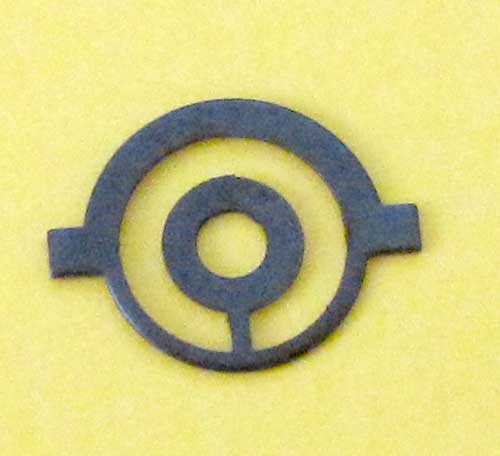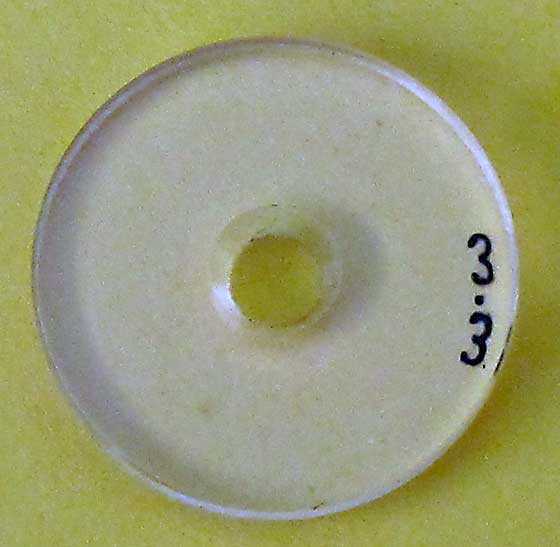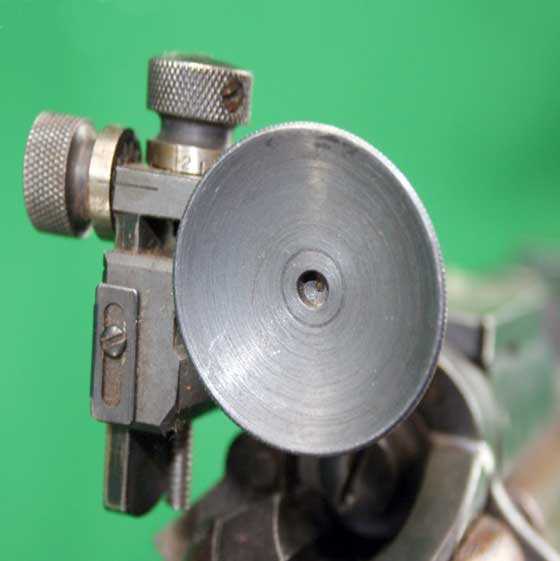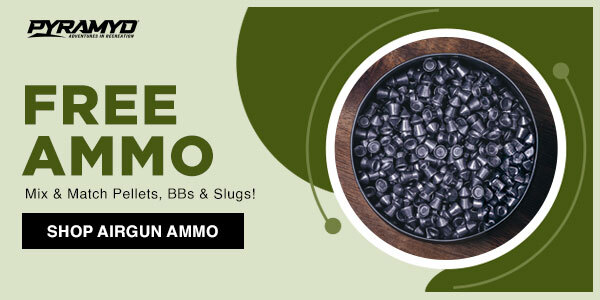by Tom Gaylord
Writing as B.B. Pelletier
This report covers:
- First encounter
- The front sight
- HOWEVER!!!
- Irony
- The deal
- Problems with the post sight
- Other front sights
- Contrarians
- Dial-a-sight
- The best front sight insert
- The clear aperture front sight
- Summary
Today we will look at the front sight that works with the peep sight. Remember, the whole purpose of the peep sight is to eliminate the rear sight from the equation. So the front sight is of extreme importance.
First encounter
The first peep sight I even looked through was on a Winchester model 52 target rifle in an NRA-run course that taught me how to shoot. While other boys my age (10) were interested in baseball and football, I was only interested in shooting. So I listened to every word the instructors said and I tried to do what they told me, to the best of my ability.

The Marble target sight on the Winchester 52 seemed remarkable to a 10-year-old boy!
There were also Springfield 1922 M2 target rifles available in this course. I tried one once and found I could not shoot it as well as I could the Winchester. Its peep sight seemed more primitive (it really wasn’t) and the front sight was just a naked post, where the Winchester had a globe with inserts. I also felt the trigger was not as responsive and the entire rifle that weighed only around 9 pounds, seemed too light. In later years I owned a 1922 Springfield and found it to be extremely accurate, but at age ten I wasn’t as accustomed to target rifles, and the heavier Winchester seemed to be the better choice.
The front sight
I shot the sights that they had and never had a chance to compare front sights. The Winchester 52 I shot had a narrow post front sight that looked as wide as the bullseye at 50 feet. I think that post sights were all they had available in that course, because that was how they taught us to see the sight picture.
![]()
The sight picture.
HOWEVER!!!
And this is where my schooling began! One instructor told us to just touch the bottom of the bull with the top of the front post, while another instructor told us if our eyes were really sharp we should leave the smallest sliver of light between the bottom of the bull and the top of the front post. Which one was right?

The two competing sight pictures we were told were correct.
Irony
The irony was, both were right! Two different sight pictures that were both correct. But which one was really right?
As it turned out, they were two different sight pictures, either one of which worked well, as long as the shooter applied it consistently. But the instructors didn’t say that. One said one thing and another said the other and I floundered with it for many, many years.
The deal
As penance for all my enabling I will now explain how both sight pictures can be correct. It turns out that the sight picture where the top of the front post touches the bottom of the bull is the easier of the two sight pictures for most shooters to achieve and it is the one that I believe should be taught to everyone. It is the sight picture you have always read in my writing.
But some people have better eyes! The problem with the first sight picture is it’s difficult to tell how MUCH of the front post is actually touching the bottom of the bull. Some will barely touch it while others will flatten the bottom of the bull just a bit. And even that isn’t bad, as long as it’s done consistently. But it’s hard to do consistently. And when you vary you get vertical stringing, or in matches where each bull is shot separately — a lower score.
Worse still is when the shooter does it while sighting in before the match. Then they just shoot a lower score than they should have and it is extremely difficult to figure out why.
If you have really sharp eyes it may be possible for you to control how much of a sliver of light you leave between the front post and the bull. I have played with that sight picture off and on for the past 50 years and finally decided my eyes have never been good enough to sight that way.
Problems with the post sight
All of the discussion above is the reason why the post front sight is not preferred today. In fact it has been out of vogue for many decades.

Three front post inserts — the right one obviously from a different globe. They illustrate the range of post sizes that are available.
I favor a narrow front post that is no wider than the bull, if I can get it. But other shooters like the wider posts and like to center the bull on them.
Other front sights
Before we look at the front sight that is widely regarded as the best, there are other front sights to consider. A peep sight allows for any kind of front sight, including types that cannot be used with an open rear notch.

A Zimmerstutzen front sight is a tiny bead on a super-fine post. The bead goes over the target where you want the bullet to strike. Zimmers shoot at 49-50 feet (15 meters), so this is a game where good vision is a plus!

These sporting sights can also be used with a peep sight. They are sometimes used with bullseye targets, but usually only when a post or aperture is unavailable.

What the…? I have never understood why a front sight insert like this exists. Is it for shooting Klingon warbirds?

This card of inserts for the Lyman 17 globe front sight has some strange ones on the upper and lower right.
Contrarians
And then there are those contrarian shooters who prefer to have their inserts appear to be hanging, rather than standing in the front globe. This happens most often with the front aperture insert. Since the aperture is simply a circle that’s centered inside another circle, and since the goal is to put a third circle, the bullseye, inside that, it makes no difference whether the aperture is standing or hanging.
Dial-a-sight
Finally, there have been a great many rimfire rifles whose front sight has several possible inserts, all contained in a unit that’s part of the rifle. Mossberg was famous for it!

The front sight on this Mossberg 46M (a) has any of four possible front sight inserts, all contained within the front sight base!
The best front sight insert
For target shooting there is one front insert that stands above all others. It is an aperture, just like the peep sight in the rear, only this one cooperates with the round shape of a bullseye to define the target with more precision than any other insert.

The front aperture is the most consistent insert in the game.
Aperture front sights came in vogue after World War II and have remained there ever since. They are nearly as intuitive as the peep sight itself for aligning a bullseye. Only one thing remained — to get rid of the thick solid ring around the hole so target shooters wouldn’t get confused and shoot at the wrong bull. Because if they do they either lose the shot, or, if two bullets land on the same bull, only the lower score counts.
The clear aperture front sight
When the clear or transparent aperture front sight inserts came out they displaced all other inserts, leveling the playing field in the target shooting game. A shooter using a post front insert has no chance against them and too many shooters have shot the wrong bull to ignore the value of a less obstructed view of the target.

The clear aperture. As you can see, the holes come in sizes to suit the shooter. This one is 3.3mm. When light enters from the front (target), the beveled cut becomes a black ring.
In competition conditions with proper lighting, the beveled hole in the clear insert becomes black, but it is much thinner than the circle of the older steel inserts. The thickness of the black ring is controlled to some extent by the angle of the beveled cut. And it encircles and centers the bullseye perfectly. I doubt there is any world-class competitor today who does not use clear inserts.
Summary
This series was a look at peep sights, with the focus on how they help those who shoot with iron sights. In Parts one through three we looked at the peeps themselves, and today we looked at the front sight they interact with.
The peep sight is one of the most misunderstood pieces of the shooting world. It is far more important than many believe and yet it is overlooked and avoided by those who think it is difficult to use.


B.B.,
I’ve always wondered what led to the development of the use of a clear disc with a hope in it as a front sight. Thank you for the history lesson.
Siraniko
BB,
I am one of those who are just crazy about peep sights. They are the cat’s meow of non optically enhanced shooting. The front sight on that Zimmerstutzen would be an awesome hunting sight if it were not so delicate.
The clear aperture in a front globe sight is indeed the best for target shooting at a round bullseye, but in a hunting situation I prefer the sharp pointed post or the perlkorn bead. The very point is your point of aim (POA).
Your Klingon Warbird globe sight was likely developed for moving targets, such as in “running boar”. There are different variations of this used in various hunting and/or sniper scopes. It is easier to quickly center your target and keep it centered than it is to hold a fixed point/dot/intersect on a moving target. Hold over becomes more difficult with this sight, but not impossible. It also works better in low light conditions than “cross” reticles. The dual X or 30/30 reticle developed from this.
RidgeRunner,
Like you, I am a huge fan of peep sights! But whereas B.B. did a lot of shooting with target rifles, where a front aperture would make sense, my use of peep sights was mostly plinking, and some hunting.
Hence, on air rifles, I like a nice thin front post, with the sight adjusted so the pellet hits the center of the top of the front post. For my Winchester .30-30 hog rifle, I had a ghost ring peep sight on the rear, and an Ashley Outdoor Express front sight; their ad pic is exaggerated in size to clarify how the sight is used, but actually, it is much cooler than the ad shows; the front sight is narrower than it appears, but with that white line in the center of it, it is an AWESOME sight to use at twilight!
As noted previously, I once shot a moving wild boar 15 minutes after sunset (the absolute end of legal shooting hours in Florida); he was moving through a cypress swamp, but a Winchester 94 is a fast action rifle…and even faster to get into action without a scope on it. I snap shot that hog at 30 yards, and put a bullet right through his heart…thanks to an excellent set of peep sights.
Hence, those who have never used a peep sight might wish to try one (seriously).
I have an extra Williams peep sight in my drawer here just itching for a rifle on which it can be used. =>
Take care & good shooting (loving those peeps!),
dave
Dave,
I’ll take it.
I always zero to the top, center of the front sight. If I was to shoot at a 10 meter target as BB recommends, I would hit at the very bottom of the circle/dot/etc.
Yep; same here. =>
RidgeRunner,
Spot on! B.B.’s Klingon Insert was covered in detail one evening at the at the Hotel Lutz in Kaltentahl by our German hunting class instructor. He instructed that you can lead the Boar by using the limbs…as he said, “Gott hilfe euch das ihr nie das untere Arm benutzen müssen!” Which translates to: God help you that you never need to use the bottom point! I quickly understood that to indicate that the Boar was charging you….
As far as the thin front post concern i get that here in the USA; however in Germany the forest underbrush is cleared almost to a fault by the Woodcutter!
shootski
BB,
This was a nice look at peeps. As I have said before, I love the peep on the 499. I use the aperture style, 2nd to last picture,…one of several as I recall. At the 22′ I shoot at and using 9/16″ ring binder paper reinforcement stickers (blackened on white paper),….. I actually took a very small washer and did a press fit (slight tap with a pin punch and hammer) and it now allows just the slightest bit light around the sticker. It is impossible to not get a perfect target picture and very precise alignment. Before the added washer,… the ring of light was much larger,… which meant there was more guessing/subjectivity with regards to target/bull alignment.
I would love to try the clear inserts sometimes. I am surprised you did not make a picture/pic on what one would appear like to the eye.
In your picture of the clear aperture,… is it actually “glass clear”? It appears somewhat opaque in the picture.
Chris
Chris USA,
You might find this interesting. It’s from a 10 meter coach’s perspective. https://www.youtube.com/watch?v=l2Id8yFl3Nk
Siraniko
Siraniko,
Indeed,.. I did find it interesting! That adjustable one is very cool and great for convienance!
Yes, reducing that band of light is exactly what I did and for the very same reasons.
That is a good link and well worth the 3 minute watch ya’ all.
Thanks,….. Chris
Chris,
The “glass” is crystal clear. A picture of it would be a picture of a thin black ring floating in space.
B.B.
Chris,
As BB said, you have a black circle floating in the air. You center your aim point in the circle. They make different size apertures, depending on the range and preference. They are the awesomest non optical sights you can use. They also make a front iris that is adjustable.
Can a sight radius be too long when using peep sights?
Will,
There must be a limit, but it’s pretty far. The Winchester 52 has a 27-inch barrel, just to extend the radius. And I have seen black powder target rifles with barrels over 30-inches. The 38-55 Ballard rifle I used to own has a 30-inch barrel with the peep sight mounted on the tang — several inches farther back.
B.B.
Will S.,
From the optical effect as long as the ring or post is sized to the target not untill it touches the target face…Lol! You can actually try that gift wrap tubing. Look through the long one almost touching your target then hold the same eye-to-target standoff and start cutting the tube down in length.
The Bloop Tube (front sight extension) on the end of 10M rifles (and other rifles and pistols) extends the sight radius without needing the longer barrel that would actually decrease accuracy due to longer barrel time. Rules are also used in competition to keep the Bloop Tube lengths from getting out of hand.
shootski
BB
Really enjoy this series.
I have a clear insert on my FWB300S. It amazes me how that black ring appears out of nothing. Would you or a reader explain insert sizes. They come in different diameters. Is this outside diameter? Metric?
Thanks
Deck
Deck,
I didn’t explain that, did I. Yes, they do come in sizes and you need to get it close for the insert to fit. Most if not all are metric sizes, even the ones AirForce makes. They are held in by the threaded tube of the globe sight, so they can be a little off. They can always be made a little smaller, if needed.
B.B.
Decksniper,
Check this out on YouTube https://www.youtube.com/watch?v=l2Id8yFl3Nk
Siraniko
Siraniko
Thanks!
Deck
Hey Tom! I HAVE to agree with you on ” The peep is useless on a pistol, but it looked cool.” However, I recvd an OLD Stevens Diamond 43 .22 pistol years ago that research showed as used a a great competition gun WITH PEEP SIGHTS. I agree that holding a pistol at arms length & expecting to see ANYTHING through its 0.050″ aperture was just NOT happening. I committed a major sin by drilling it out to 0.104″ and can now SEE through it. Best I’ve done now is 4.4″ group at 50 ft.
Barrika,
Those Stevens 43’s are great single shot pistols. And there were detatchable shoulder stocks that weren’t much more than heavy wire that allowed them to become baby rifles.
I bet your pistol can do even better, once you find the right ammo.
Here is a picture of a Stevens 35 I once owned.
B.B.
BB
Definitely would like to have one of those pistols with a wire stock. Cool stuff.
Wow, B.B.! What a sweet pistol. =>
Nice series.
My first exposure to a peep sight was on my dad’s M1 Carbine, (i would call it more an apeture sight instead of a peep sight though.)
In my late teens, I bought a Remington 513T that came with match sights, I tied them squirrel hunting one day.
I found if you waited for them to stop, it was easy, but for moving targets, forget it.
And if you were hunting fox squirrels, they tend to stay in one spot if they don’t think you saw them.
but the cat squirrels (gray squirrels) they are more antsy, and don’t say in one spot for too long, and were definitely a more challenging target.
Ian
Yes, BB, but I see on careful viewing your pistol that IT had a NOTCH sight, not a PEEP! 🙂
Barrika,
If you refer to the Daisy Targeteer, flip that notch back and it’s a peep.
B.B.
Hi BB,
When I taught my daughters to shoot I used an IZH 60. I tried a scope, red dot, open sights, and a set of front and back aperture sights. Neither of the girls could get the scope or red dot to work and it wasn’t much better with the open sights but when I tried the apertures, they were instantly hitting the cans they were shooting at. I think sighting through front and rear apertures is the most instinctive method of sighting.
David Enoch
“I think sighting through front and rear apertures is the most instinctive method of sighting.”
Roger that, David; I concur. =>
Random fact. When Carlos Hathcock shot NM with irons at Camp Perry, he used a centre hold with rear aperture and blade front sights. And won matches doing so.
That guy’s eyesight must have been incredible.
B.B.
2 issues which I wish you would discuss are “mixed dominance eye sight” and hold over with peep/apiture sights.
For a 2 inch drop, do aim normally but 2 inches higher(my method) or tilt the weapon like Elmer did?
-Y
B.B.,
I stumbled upon a firearm sight that is essentially a single-unit glowing aperture sight with front sight all in one: the Meprolight FT Bullseye. It looks kinda goofy to me, but it’s expensive, so maybe it works well.
Michael
And here.
B.B.,
Here’s a relatively new handgun sight that borrows from the wide post sight picture called Big Dot. It’s a Tritium front sight with a vertical line rear sight centered on a gull-wing thingy. I believe the theory behind it is that handgun sights need to be conducive to lightning quick acquisition rather than sniper precision, given that gunfights are usually at distances of 7 yards or so (if I recall having read correctly).
Michael
Michael,
Very interesting. At such close range, though, I prefer to rely on the instinct method.
B.B.,
Instinct shooting, yes. Lucky McDaniels had an excellent handle! :^) Here’s one I just came up with:
What did the sniper say at the Gunfight at the O.K. Corral?
“Hold on, I’ve got to line up my sh . . . .”
Michael
Michael,
Windage, range, temperature, humidity, elevation to sea level,………… 😉
Chris
=8^D
BB,
Yes, it is interesting. What about those lasers that are incorporated into the grips on a pistol/handgun? That seems like an absolute no brainer. Maybe not? Maybe only good for dark use?
Chris
Chris,
Maybe laser “sights” would be fine for shotguns, but I have always wondered if those might have the potential to make a shooter “try too hard” or think too much. How could one keep the laser point still on an object 50 yards away, or even 25 yards away? I have a problem of freezing when I use a scope that has too great of a magnification. The crosshairs move about on the bullseye ever so slightly. But ever so slightly is too much — aaaargh. At some point you just have to squeeze the trigger and have at it.
Perfect is the enemy of good.
Michael
Michael
Is the laser for you to use or is it to put a little more realization into who the lazer is getting pointed at.
Yes at some point the trigger might need to be pulled.
A lazer is much quicker than the other sights. No doubt. As accurate. Well that depends on how much time you have and what your shooting at and how far away. And yes among other things.
Michael,
You seemed to be talking about hand guns and self defense type situations. That is why I thought of the grip lasers. Assuming they can be seen well in the daylight,…. I can’t imagine anything being easier to just point and shoot at 20 feet or so. Of course, the benefits in the dark seem obvious.
Chris
Chris,
You are correct on both points. Yes, those are handgun sights. And yes, lasers seem ideal for quick and close. I usually don’t think in those terms as an airgunner who shoots at small objects far away.
Michael